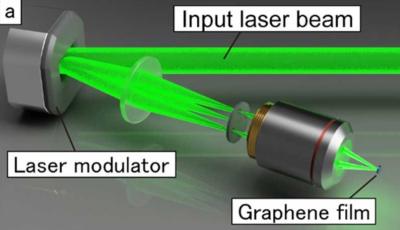Earlier this year, Tohoku University researchers created a technique that could micro/nanofabricate silicon nitride thin devices with thicknesses ranging from 5 to 50 nanometers. The method employed a femtosecond laser, which emitted extremely short, rapid pulses of light. It turned out to be capable of quickly and conveniently processing thin materials without a vacuum environment.
By applying this method to an ultra-thin atomic layer of graphene, the same group has now succeeded in performing a multi-point hole drilling without damaging the graphene film.
"With proper control of the input energy and number of laser shots, we were able to execute precise machining and create holes with diameters ranging from 70 nanometers - much smaller than the laser wavelength of 520 nanometers - to over 1 millimeter," says Yuuki Uesugi, assistant professor at Tohoku University's Institute of Multidisciplinary Research for Advanced Materials, and co-author of the paper.
Upon closer examination of the areas irradiated with low-energy laser pulses, which did not make holes, via a high-performance electron microscope, Uesugi and his colleagues found that contaminants on the graphene had also been removed. Further magnified observation revealed nanopores less than 10 nanometers in diameter and atomic-level defects, where several carbon atoms were missing in the crystal structures of the graphene.
Atomic defects in graphene can be both detrimental and advantageous, depending on the application. Whilst defects sometimes downgrade certain properties, they also introduce new functionalities or enhance specific characteristics.
"Observing a tendency for the density of nanopores and defects to increase proportionally with the energy and number of laser shots led us to conclude the formation of nanopores and defects could be manipulated by using a femtosecond laser irradiation," adds Uesugi. "By forming nanopores and atomic-level defects in graphene, not only can electrical conductivity be controlled but also quantum-level characteristics such as spin and valley. Moreover, the contaminant removal by femtosecond laser irradiation found in this research could develop a new method for non-destructively and cleanly washing high-purity graphene."
Looking ahead, the team aims to establish a cleaning technique using the laser and carry a detailed investigation into how to conduct atomic defect formation. Further breakthroughs will have a big impact on areas from quantum materials research to biosensor development.
